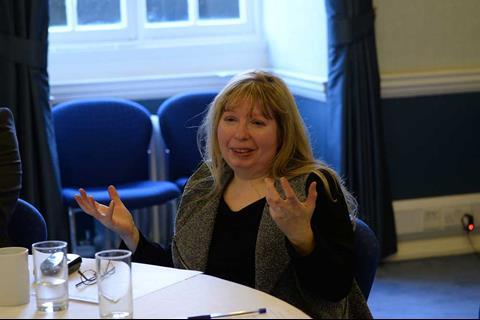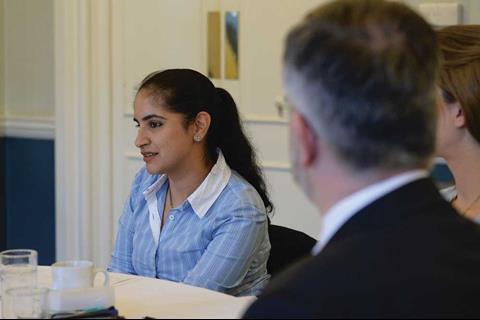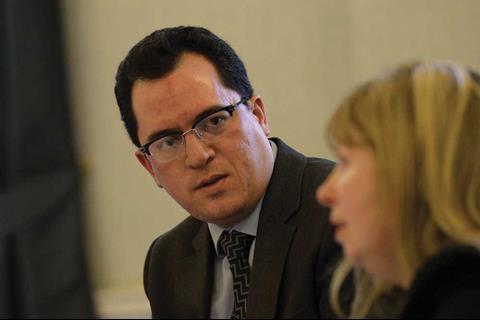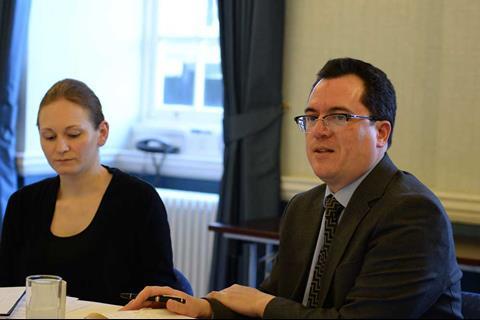Eduardo Reyes reports from a roundtable bringing together in-house lawyers who must reconcile the interests of the public and policymakers in not-for-profit organisations.
This Gazette roundtable featured in-house lawyers who share common traits. They work for organisations ultimately funded by those they regulate, or the taxpayer. All must cope with the growing expectations of policymakers and the public, in an environment of diminishing resources.
And unlike their peers in local government, this group is not considering the prospect of delivering services to clients by becoming an alternative business structure, thereby creating an entity that could turn a profit and relieve their budgets.
For Helen Shay, in-house solicitor at the University of York, striking a balance between conflicting duties is a core challenge – and central to the university’s ability to fulfil public policy aims that expose unresolved tensions.
‘There is talk of bringing in [new] duties for universities to prevent extremism and recruitment [to extreme causes],’ she explains. Yet her employer also has ‘a duty to promote freedom of expression and equality’.
Such considerations come to a head, Shay notes, when external speakers are invited on to campus. ‘Sometimes we insist that they don’t discuss certain topics – it depends,’ she observes. And what about a duty to be fair? In areas such as checking immigration status, she says, universities are ‘being made into an arm of government… to help enforce immigration policies.
‘We really don’t like that,’ she adds.
This strikes a chord with Kavita Savani, a lawyer at the Financial Ombudsman Service and committee member of the Law Society’s In-house Division.
‘We are an impartial organisation,’ she stresses. ‘We’re not on the side of the consumer or business, although we have duties that are set out in the statute through which it was established.’
The ombudsman is not a public authority and is funded by a levy on regulated businesses. But it must operate in an environment where ‘parliament is constantly making new legislation’.
Weighing the interests of clients and policymakers regularly tests the judgement of all the lawyers around the table. This must be reconciled with their own duties as regulated professionals.
Savani acknowledges that, in itself, regulation based on ‘outcomes’ or ‘principles’ is ‘more useful than a rules-based approach’. But that is partly because ‘legal education, training and regulation is designed with private practice front of mind’.
Lawyers working in-house face a common challenge in seeking to demonstrate their value in compliance. Shay says: ‘This job is difficult and you are often the bearer of bad news. In these circumstances, the in-house lawyer commonly faces the response “Oh, here we go, business prevention department again”.’
But Shay stresses: ‘I come again and again to the old adage: “speak truth to power”. However frightened I have been of saying what people don’t want to hear, this has always ended up setting the organisation back on the right road.’
Nick Glockling, legal director at the Legal Services Board, has worked for Postcomm, Treasury Solicitors and Ofgem. He observes: ‘In a politicised environment, it is very often the case that powerful stakeholders have a particular view of what the public interest requires. The professions are very clear that they are the guardians of the public interest.’
One upside, Savani notes wryly and to general agreement, is that for all these competing pressures, lawyers in public roles at least do not have to meet billable hours targets. ‘You are always thinking about wider issues,’ she notes.
Identifying risks
All agree that the discrete legal risks faced by public bodies have increased. The fact that non-lawyers generally recognise this has increased the profile of in-house teams. However Paul Bentall, former head of resolution, professional standards at a professional regulator, sounds a note of caution about who actually ‘owns’ those risks.
‘It doesn’t sit well for the senior lawyer of an organisation to be the sole holder of risk or, more particularly, the legal risk,’ argues Bentall, who has worked for insurer AXA and the Financial Ombudsman Service. ‘The in-house lawyer has a role to play, but everything [should not be] moved on to the lawyer’s desk.’
In ‘most sophisticated organisations’ it would be ‘anathema’ to have such a ‘shambolic approach to risk management’, he suggests. Glockling concurs, but adds the caveat: ‘The only way to effectively manage risk is to enable your lawyers to know what’s going on.’
One obstacle to achieving ready access to information is an inadequate appreciation in the rest of the organisation of the value that in-house lawyers add – value that cannot be provided by private practice advisers, he adds.
‘In-house lawyers tend to undersell themselves a bit,’ Glockling says. ‘They will actually be doing a lot more than just providing legal advice. The trouble is, because they’re doing it by second nature, they’re not always that good at identifying the extra contribution they’re making.’
He adds: ‘It’s quite hard to compare like with like, because the services you receive from an external legal adviser will often be quite different. Very often, the missing [element] is tailoring the advice to your organisation.’
Adding value
This job is difficult and you are often the bearer of bad news. The in-house lawyer commonly faces the response ‘Oh, here we go, business prevention department again’
Helen Shay, University of York
Strategies for demonstrating the value provided by in-house legal teams vary. ‘I think we are naturally loath to blow our own trumpets and highlight the value we can bring,’ Bentall notes. ‘But I think it’s important that you do that in a systematic and structured way.’ He underlines the importance of ‘making sure that you network properly within the organisation’.
Shay recalls the notional ‘hourly rate’ used by the in-house team of a building society where she once worked. This enabled a straightforward cost comparison with external lawyers.
More important in her current role, she suggests, is to keep a simple note of positive feedback the legal team receives. Being able to cite such feedback is useful: ‘It’s small scale where I am,’ she says. ‘But it works.’
This is an approach that others also prefer. Outside the private sector, the hourly rate comparator can set the wrong tone for a legal team that is reliant on what Savani calls ‘a seat at the table’ – necessary for identifying risks at the outset.
Glockling reflects: ‘The LSB is a young organisation, and had the opportunity to decide what culture it wanted. [We] started with a blank sheet of paper.’
He says the board and its chair [David Edmonds] ‘didn’t want lawyers hiding behind some sort of professional barrier’.
‘Over the years, whenever the discussion has come up about whether lawyers should be time recording, I have said we could do that quite straightforwardly,’ he recalls. ‘But what becomes apparent is that the rest of the organisation doesn’t want that. It wants colleagues to come up to you at your desk to talk issues through. A lot of advice is given informally.’
Glockling concludes that it is counterproductive for lawyers to respond to a query by ‘starting the clock’ or saying, ‘you need to schedule an appointment to speak to me’.
‘Culture is really, really important,’ he stresses. ‘As in-house lawyers, we demonstrate value by the fact that our colleagues want us involved in what they’re doing. They don’t hide their work from the legal team. You don’t put pounds, shillings and pence on that, but that’s definitely noticeable if you get it right. You’re visible – that’s the thing.’
More systematic reporting can be useful, of course, and Savani notes that the Financial Ombudsman Service has increased activity in this respect. Reports to the CEO and chief ombudsman on litigation have always been a staple requirement. But more recently, she says: ‘We’ve been trying to measure the other types of work we’re doing and provide regular fortnightly updates to the CEO and the chief ombudsman. It’s a quick email that comes from the head of department, but everyone in the team contributes and says what they’re working on. People at the highest level are aware of what we’re doing as a team, which has been very helpful.’
Like Bentall, Shay stresses the importance of networking: ‘This is enormously important,’ she says. A member of the Association of University Legal Practitioners, she notes: ‘It is a friendly sector. For example, I’ve been shown counsel’s opinion [where another university has encountered a similar issue].
‘In that situation you can say, “well look, because I’m here you’ve got sight of the counsel’s opinion that would (otherwise) have cost you X thousand pounds.’
Working in a larger legal team than others present, Savani’s colleagues are in a position to collate more data. Every month, she says, ‘a couple of members of our team look at some of the queries which come [via the] legal hub, from where they are referred by the rest of the organisation.
‘We look through interesting cases which might affect the Ombudsman Service, or new legislation. All that information is collated in a one- or two-page newsletter that goes out on the intranet.’
We are an impartial organisation. We’re not on the side of the consumer or business, although we have duties that are set out in the statute through which we were established
Kavita Savani, Financial Ombudsman Service
This also complements training run by the legal team on topics such as ‘judicial review risk’.
The time devoted to (and opportunities for) winning ‘trust’ from an organisation are hugely valuable, and define the success of the role, Shay notes. ‘Once they trust you then they’ll listen. And then they’ll realise that what you’re saying is important.’ But proximity to non-lawyer colleagues – in many instances being located in their departments rather than in a centralised, separate legal team – can carry its own risks.
‘Although working beside non-lawyer colleagues builds relationships and underlines the in-house lawyer’s role as a team player, can’t it also leave you vulnerable to pressure from colleagues?’ the Gazette suggests.
‘Welcome to our world,’ quips one attendee. Yet there is a consensus that the benefits of proximity outweigh those risks.
Adding to the benefits the in-house legal team can deliver is its role in ‘horizon-scanning’. Bentall explains: ‘Legislation risk, for everybody who has worked in the public eye – not just the public sector – is an issue we have to be aware of.’ He adds: ‘Of course, it’s not just domestic legislation, it’s European legislation as well, so I would certainly expect to see that built into a risk management framework.’
It is critical too that ‘risk management frameworks and tools are “live” documents; not just something that’s drawn up and put away in a drawer’, Bentall adds.
In training
Finally, the group turns to education and training. There is general support for the notion that the in-house sector benefits from flexibility when it comes to ‘points of entry’ to the profession.
Savani has direct experience here: ‘I did the LPC part-time while working in the legal team at the ombudsman service… Obviously, with the costs involved of further education, the possibility of getting a training contract in the traditional way isn’t as straightforward as it used to be.’
The result, she notes, is that more ‘people are looking at different routes to enter the legal profession [not just private practice]. I think that’s a good thing.’
New entrants to the legal market as it liberalises, and the developing role of technology in delivering advice, will also change what it is needed from lawyers, Bentall notes.
Glockling adds: ‘I think the interesting thing for all of us to think about is the fact that we’ve all been through a system that focuses very, very heavily on entry – getting over a set of hurdles at the start of your career.’ There is, he says, ‘an important debate to be had as to whether that’s appropriate for the future. Obviously the world changes very quickly, the market changes very quickly, what we expect laws to do will change. So are we putting too much emphasis on the level people reach at the start of a career which may last for 40-plus years?’
Paid-for training and career development opportunities have certainly been at a premium in recent years. Before the financial crisis, Shay says she ‘was sent on lots of wonderful courses at that time, really good ones, human rights and all sorts. Then after that the world turned upside down and there was a lot of pressure to access it for free’.
The fact that such training is often available free for in-house lawyers – as part of private practice efforts to build strong relationships – has reduced the impact of changes to solicitors’ CPD requirements.
As is the case in all but the largest legal departments, career development for lawyers in-house is a challenge. Glockling suggests using opportunities within the organisation, but outside the legal department: ‘It’s very important that people do get as much experience as they can of what’s going on within the organisation and its different facets.’
Others stress the importance of soft-skills training and development. These skills include negotiation, communication and management training. Glockling notes: ‘I came from private practice and one of the first challenges I had as an in-house lawyer was how to communicate in a language that my senior management understood.’
He was ‘keen to demonstrate my legal knowledge around a particular issue, writing a full and comprehensive report’, when in fact this created a situation where the client was ‘not necessarily understanding what I was saying’.
As with other areas of practice, different communication norms are changing the language of organisations.
Savani describes the impact of social media as ‘huge’. Legal and comms teams collaborate to ‘make sure that the way we communicate with our customers and the public is friendly, and in a language that people can understand’.
‘Key priorities this year, which the legal team is helping advise on, are new service areas. So how can we have a presence online, [and] communicate with our consumers quicker electronically in the digital era? Obviously there are legal risks attached and we’re helping the organisation in that respect.’
Closing the discussion, Glockling alludes to a ‘generational shift’ for ‘customer-facing communications’.
‘They’re looking for other forms of communication which tell them the same thing, but tell them more quickly, and get to the point at issue immediately,’ he points out.
Eduardo Reyes is Gazette features editor







































1 Reader's comment